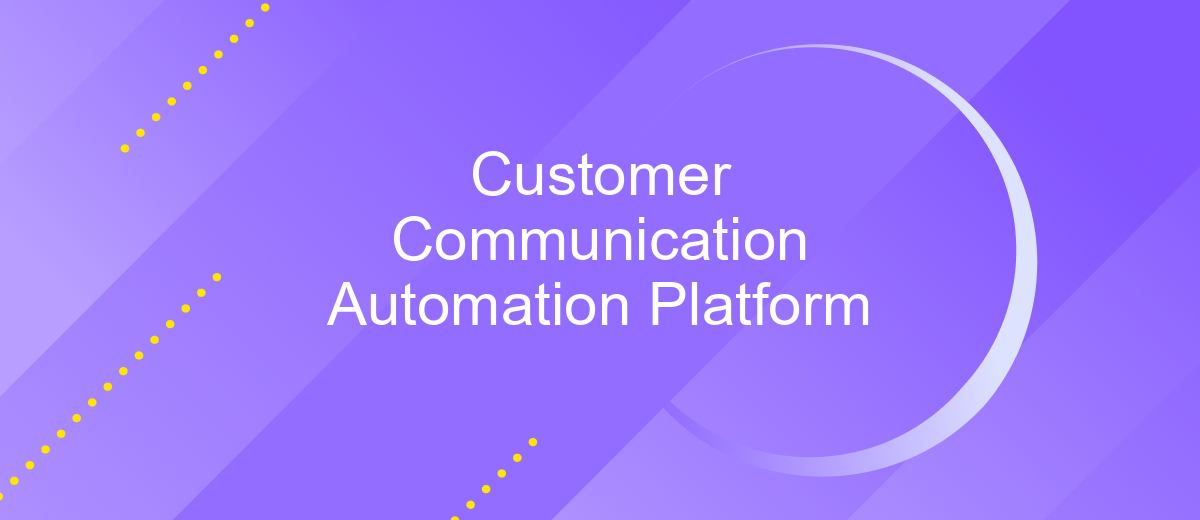Customer Communication Automation Platform
In today's fast-paced digital landscape, businesses are increasingly turning to Customer Communication Automation Platforms to enhance their interactions with clients. These platforms streamline communication processes, ensuring timely and personalized engagement across multiple channels. By leveraging advanced technologies like AI and machine learning, companies can significantly improve customer satisfaction and loyalty, ultimately driving growth and efficiency. Discover how automation is transforming the way businesses connect with their customers.
Introduction
In today's fast-paced digital landscape, businesses are continually seeking innovative ways to enhance customer interactions and streamline communication processes. A Customer Communication Automation Platform (CCAP) emerges as a pivotal solution, enabling companies to automate and optimize their communication strategies. By leveraging advanced technologies, these platforms empower businesses to deliver personalized and timely messages across multiple channels, ensuring a seamless customer experience.
- Automated messaging: CCAPs enable the scheduling and sending of messages without manual intervention.
- Omni-channel support: These platforms facilitate communication across various channels such as email, SMS, social media, and more.
- Personalization: CCAPs allow for tailored messaging based on customer data and behavior.
- Analytics: They provide insights into communication effectiveness and customer engagement.
- Integration: CCAPs can be integrated with existing CRM and marketing tools for cohesive operations.
As businesses strive to maintain competitive advantage, adopting a Customer Communication Automation Platform can significantly enhance their ability to engage with customers effectively. By automating routine communication tasks and providing valuable insights through analytics, these platforms not only improve operational efficiency but also elevate the overall customer experience, fostering loyalty and driving growth.
Benefits of Customer Communication Automation

Implementing a Customer Communication Automation Platform significantly enhances efficiency and personalization in business interactions. By automating routine communication tasks, companies can ensure timely and consistent engagement with their customers, leading to improved satisfaction and loyalty. Automation tools allow for segmentation and targeted messaging, ensuring that customers receive relevant information tailored to their preferences and behaviors. This not only saves time but also reduces the margin for human error, ensuring that communications are accurate and professional.
Moreover, integrating these automation platforms with existing systems can be simplified using services like ApiX-Drive. This service facilitates seamless integration, allowing businesses to connect various applications and automate workflows without the need for complex coding. By streamlining integrations, companies can enhance their operational efficiency, ensuring that all customer interactions are captured and leveraged across different platforms. This holistic approach to communication not only strengthens customer relationships but also provides valuable insights into customer needs and trends, enabling businesses to adapt and innovate proactively.
Features to Consider

When selecting a Customer Communication Automation Platform, it's crucial to evaluate features that align with your business needs. A robust platform can enhance customer engagement and streamline communication processes, leading to improved customer satisfaction and loyalty.
- Omnichannel Support: Ensure the platform supports multiple communication channels such as email, SMS, social media, and chat to provide a seamless customer experience.
- Personalization Capabilities: Look for features that allow for personalized messaging based on customer data and behavior to enhance engagement.
- Automation and Workflow Management: The platform should offer advanced automation tools to manage workflows, trigger actions, and schedule communications efficiently.
- Analytics and Reporting: Comprehensive analytics and reporting tools are essential for tracking performance, understanding customer interactions, and optimizing communication strategies.
- Integration Options: Check for easy integration with existing CRM systems and other business tools to ensure a unified communication strategy.
By carefully considering these features, businesses can select a Customer Communication Automation Platform that not only meets their current needs but also scales with their future growth. This strategic choice will enable more effective communication, fostering stronger customer relationships and driving business success.
Best Practices

Implementing a Customer Communication Automation Platform effectively requires strategic planning and execution. Begin by clearly defining your communication objectives and understanding your audience's preferences. This ensures that the automated messages are relevant and engaging, enhancing customer satisfaction.
Next, integrate the platform with your existing systems to streamline data flow and maintain a unified customer view. This integration helps in delivering personalized messages based on real-time information, thereby increasing the likelihood of positive customer interactions.
- Regularly update and review your automated communication workflows to ensure they align with current business goals.
- Segment your audience to tailor messages that resonate with specific customer groups.
- Utilize analytics to track the performance of your communications and make data-driven improvements.
- Test different messaging strategies to identify what works best in terms of engagement and conversion.
Finally, ensure compliance with data protection regulations to build trust with your customers. By prioritizing privacy and transparency, you not only safeguard your business but also foster long-term customer relationships. Embracing these best practices will maximize the benefits of your Customer Communication Automation Platform.
Conclusion
In conclusion, the implementation of a Customer Communication Automation Platform significantly enhances the efficiency and effectiveness of customer interactions. By automating routine communication tasks, businesses can ensure timely and consistent engagement with their customers, leading to improved satisfaction and loyalty. This automation not only reduces the workload on customer service teams but also allows them to focus on more complex issues that require a human touch, ultimately leading to a more personalized customer experience.
Moreover, the integration capabilities of such platforms are crucial for seamless operations. Utilizing tools like ApiX-Drive can simplify the process of connecting various applications and services, ensuring data flows smoothly across systems. This integration allows businesses to maintain a unified view of customer interactions, facilitating more informed decision-making and strategy development. Overall, adopting a Customer Communication Automation Platform, complemented by efficient integration solutions, empowers businesses to optimize their communication processes, drive growth, and maintain a competitive edge in the market.
FAQ
What is a Customer Communication Automation Platform?
How can automation improve customer communication?
What are the key features to look for in a Customer Communication Automation Platform?
How can I integrate a Customer Communication Automation Platform with my existing systems?
Is it possible to customize automated communication workflows?
Do you want to achieve your goals in business, career and life faster and better? Do it with ApiX-Drive – a tool that will remove a significant part of the routine from workflows and free up additional time to achieve your goals. Test the capabilities of Apix-Drive for free – see for yourself the effectiveness of the tool.

